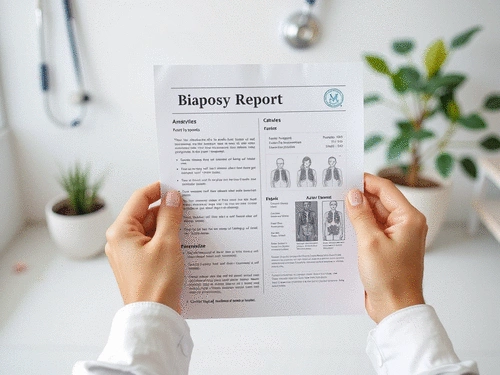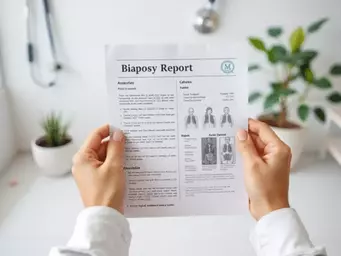Understanding your biopsy results can be a daunting process, but it’s an essential step in empowering yourself to make informed healthcare decisions. By gaining clarity on these results, you illuminate the path toward your health journey.
What You Will Learn
- Biopsy results provide critical insights into the presence of abnormalities, guiding treatment decisions.
- Understanding the difference between benign and malignant findings is crucial for your health management.
- Pathology reports detail cancer type, staging, and potential treatment responses, which are essential for personalized care.
- Grasping cancer grading helps you understand the aggressiveness of the disease, directly impacting treatment options.
- Financial transparency regarding biopsy costs and insurance coverage is vital to alleviate stress during your healthcare journey.
Understanding Key Biopsy Report Sections
This visual highlights the critical information found in a biopsy pathology report, crucial for understanding your diagnosis and treatment options.
Diagnosis (What was found?)
The specific condition identified from the biopsy sample. This is the core finding.
Margins (Is it all gone?)
Information on whether cancerous cells are present at the edges of the sample. Crucial for surgical success.
Grade (How aggressive?)
A description of how abnormal the cells appear, indicating the potential aggressiveness of the disease.
Staging (How far has it spread?)
Details about the extent of the disease and whether it has spread to other parts of the body.
Understanding Your Biopsy Results: An Overview
Receiving your biopsy results can feel like a whirlwind of emotions. In this section, we’ll explore what these results mean and why they’re crucial for your health journey. Essentially, biopsy results provide essential insights into the nature of any abnormalities found in your tissue samples. Understanding these results is a vital step in making informed decisions about your health.
By grasping the significance of your biopsy results, you empower yourself to engage actively with your healthcare process. It’s about transforming anxiety into informed choices, which is a primary goal here at What Is A Biopsy.
What Are Biopsy Results and Why They Matter
Biopsy results are reports generated after analyzing tissue samples taken from your body. These results help your healthcare provider determine whether any abnormalities, such as tumors, are present. Knowing the specifics of your biopsy results is essential, as they can lead to critical decisions regarding your treatment options.
- Understanding the difference between benign and malignant findings
- Recognizing the implications for treatment planning
- Seeing how results influence further diagnostic testing
These results serve as a foundation for your medical care. They guide your healthcare team in crafting a personalized treatment plan tailored to your needs. Trust me, having this information at your fingertips is invaluable!

The Importance of Pathology Reports in Cancer Diagnosis
Pathology reports are often a cornerstone in cancer diagnosis and management. These reports don’t just state whether cancer is present; they provide detailed information about the type of cancer and its characteristics. This helps in understanding how aggressive the cancer may be and what treatment options are most suitable. For more in-depth information, the National Cancer Institute provides a comprehensive fact sheet on understanding pathology reports.
The information contained in these reports can clarify:
- The specific type of cancer
- How far the cancer has spread (staging)
- Possible treatment responses based on tumor markers
As a board-certified pathologist, I’ve seen firsthand how critical a well-detailed pathology report can be in steering the course of treatment. This is why I’m so passionate about helping patients understand every aspect of their biopsy results! The American Cancer Society also offers valuable guidance on what's included in a pathology report, which can be a helpful resource for patients.
Key Insights into Cancer Grading and Staging
Grading and staging are crucial elements in understanding cancer. Grading refers to how abnormal the cancer cells look under the microscope, while staging indicates the extent of the cancer's spread in the body. Each provides unique insights that can help tailor your treatment plan. The National Cancer Institute provides further details on understanding tumor grade.
- Low-grade tumors typically grow slowly and are less likely to spread.
- High-grade tumors tend to grow faster and are more aggressive.
- Staging can range from Stage 0 (precancerous) to Stage IV (advanced cancer).
Grasping these concepts is essential for making informed decisions about your next steps. I encourage you to discuss these grades and stages with your healthcare provider, as they will play a significant role in your treatment journey!
We Want to Hear From You!
How did you feel when you first received your biopsy results? Share your thoughts and experiences with us:
Frequently Asked Questions about Biopsy Results
What is the primary purpose of biopsy results?
Biopsy results provide critical insights into the nature of any abnormalities found in tissue samples, guiding healthcare providers in making informed decisions about diagnosis and treatment.
What is the difference between benign and malignant findings in a biopsy report?
Benign findings indicate non-cancerous abnormalities, while malignant findings confirm the presence of cancer. Understanding this distinction is crucial for health management and treatment planning.
What information does a pathology report typically include?
A pathology report provides detailed information about the specific diagnosis, the presence of cancerous cells at surgical margins, the grade (aggression) of the cells, and the staging (extent of spread) of the disease.
Why is cancer grading important?
Cancer grading describes how abnormal cancer cells appear under a microscope, indicating how aggressive the disease might be. This information is vital for tailoring effective treatment options.
What should I consider regarding the cost of a biopsy and insurance?
It's important to check with your insurance provider about coverage for biopsy procedures, inquire about potential out-of-pocket expenses (co-pays, deductibles), and ask about financial assistance programs if costs are a concern.
Summarizing Your Biopsy Journey
As you reflect on your biopsy experience, it’s crucial to understand the key takeaways from your pathology findings. Each result carries with it a wealth of information that can help shape your next steps. Remember, you're not alone in this journey! I’m here to guide you through the maze of medical jargon and provide clarity.
- Your biopsy results provide essential insights into your health status.
- Understanding what your pathology report entails is empowering.
- Being informed helps you make confident decisions about your treatment options.
These takeaways can significantly influence the way you navigate your healthcare decisions. Embrace the knowledge you gain from these findings—it’s a vital part of your health journey!
Key Takeaways from Your Pathology Findings
Pathology reports might seem complicated at first, but they contain valuable insights tailored to your health situation. Here are some key sections you should focus on as you review your report:
- Diagnosis: The specific condition identified from the biopsy sample.
- Margins: Information on whether cancerous cells are present at the edges of the sample.
- Grade: A description of how abnormal the cells appear, indicating the aggressiveness of the disease.
- Staging: Details about the extent of the disease and whether it has spread.
Familiarizing yourself with these terms will create a clearer path forward. Don’t hesitate to reach out with any questions—it’s essential to understand what your findings mean!

Empowering Yourself with Knowledge and Resources
Knowledge is power! By understanding your biopsy results, you are taking control of your health. I encourage you to seek out reliable resources that can provide additional insights. Here’s a list of helpful tools and resources:
- Visit What Is A Biopsy for comprehensive articles and guides.
- Connect with local support groups or online communities for shared experiences.
- Consult trusted healthcare professionals who can help clarify any doubts.
Staying informed empowers you to ask the right questions and engage in meaningful conversations with your healthcare team. Remember, being proactive can make a significant difference in your care journey.
Understanding the Cost of Biopsy and Insurance Considerations
When it comes to medical procedures like biopsies, understanding the financial aspects is just as important as the medical findings. Here are some considerations you should keep in mind:
- Check with your insurance provider to understand what biopsy procedures are covered.
- Ask about potential out-of-pocket expenses, including co-pays and deductibles.
- Inquire about financial assistance programs if you face high costs.
Being aware of these factors can alleviate some stress as you navigate your healthcare journey. Financial transparency is key, and if you have any questions about costs, don’t hesitate to discuss them with your healthcare provider or billing department!
More Frequently Asked Questions about Biopsy Results
What If My Biopsy Results Are Inconclusive?
Receiving inconclusive results can be frustrating, but it’s important to remember that this is not uncommon. It may indicate that further testing is needed to get a clearer picture of your health. Discuss with your healthcare provider about next steps and potential follow-up tests.
How to Approach a Second Opinion on My Diagnosis?
Seeking a second opinion is a completely reasonable step, especially if you have questions or concerns about your diagnosis. Here are some tips on approaching this process:
- Gather all relevant medical records and pathology reports.
- Find a specialist who has experience with your specific diagnosis.
- Be clear about your reasons for seeking a second opinion during your consultation.
This step can provide additional reassurance and help you make informed choices about your treatment. Remember, you are your best advocate!
When to Consider Clinical Trials as a Treatment Option
Clinical trials can offer cutting-edge treatment options and are worth considering if you’re facing a challenging diagnosis. Discuss this with your healthcare provider, and consider the following:
- Are there trials available for your specific type of cancer?
- What are the potential risks and benefits of participating?
- How will participation impact your current treatment plan?
Engaging in clinical trials can sometimes lead to innovative therapies that may not be readily available, so stay curious and informed about all your options!
Recap of Key Points
Here is a quick recap of the important points discussed in the article:
- Biopsy results are crucial for understanding health status and guide treatment decisions.
- Pathology reports provide detailed information about cancer types and characteristics.
- Grading and staging of tumors are essential for tailored treatment plans.
- Familiarize yourself with key terms like diagnosis, margins, grade, and staging from your pathology report.
- Seek reliable resources and support to empower your healthcare journey.
- Understand the financial aspects of biopsy procedures and insurance coverage.








